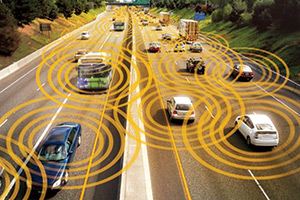NHTSA’s Proposed V2V Mandate Would Start Connectivity Network

This story appears in the Dec. 19 & 26 print edition of Transport Topics.
By the early 2020s, cars and trucks could well be swapping data with each other automatically while cruising the nation’s highways and streets, providing a broad platform to improve safety and save lives, if a proposed new federal rule on vehicle-to-vehicle connectivity is enacted.
On Dec. 13, the National Highway Traffic Safety Administration released its proposal for mandatory V2V capability for cars and light trucks. While the document does not cover heavy-duty trucks, it does set up a nationwide framework that large commercial vehicles eventually would join.
The NHTSA proposal covers only V2V transmission and reception using 5.9 gigahertz dedicated, short-range communications, or DSRC, but the document said the Federal Highway Administration, also a part of the U.S. Department of Transportation, will be following soon with guidelines to states for vehicle-to-infrastructure communications. V2I allows highways, bridges, traffic lights and other infrastructure to transmit safety information to vehicles.
“The proposal I’m announcing would allow new light vehicles to be equipped with technology to enable them to communicate effectively with each other while on the road,” Transportation Secretary Anthony Foxx said in a conference call with reporters. “This technology has enormous safety potential to prevent hundreds of thousands of crashes and save lives.”
“This is a safety tool, not a data-gathering tool,” said NHTSA Administrator Mark Rosekind, who joined Foxx on the call. “But we know that the benefits we’re seeing in the light vehicles clearly would generalize to heavy vehicles and trucks as well.
“It took us 12 years to get here and, hopefully, we’ll be able to do it faster with all the light vehicle work, but the research for trucks and heavy vehicles is going on right now.”
The proposal did not provide a specific timetable but did offer an outline: 90 days for public comment after formal publication in the Federal Register, which should happen early next year. When comment is done, NHTSA staff would construct and publish a final rule, which would have to be cleared by the White House Office of Management and Budget.
Under the NHTSA example, that might not happen until 2019, but it could be earlier. If the rule takes effect in 2019, the phase-in period for automakers would begin two years later in 2021 and finish in another two years in 2023, with 100% compliance for new vehicles at the end.
The rule applies to new vehicles and aftermarket systems for retrofitting for car owners who wish to update their vehicles. The proposed rule said NHTSA does not have the authority to demand retrofits for cars, although it can do so for heavy trucks.
Although the proposal is meant for light vehicles, people in trucking are paying attention.
“NHTSA has already mentioned doing continuing research to adapt this to trucks,” said Michael Cammisa, vice president for safety policy and connectivity at American Trucking Associations.
“Having installed a base for V2V in cars, trucks will know there’s a system producing a basic safety operating message so you can get the benefits of V2V,” Cammisa said in an interview, adding that he is analyzing the proposal and will file comments based on how truck operators would need to use the system.
Daimler Trucks North America declined to comment on the proposal for now, but in October the manufacturer’s CEO, Martin Daum, spoke about connected vehicles at a press conference.
Daum said it would be “perfect” if all cars, trucks and buses used V2V technology, but that is difficult and unlikely anytime soon. Asked if 80% connectivity would be sufficient, he said it would not.
On Dec. 12, the day before the proposal’s release, the National Coalition for Truck Parking held an event and mentioned that connected vehicles could be a useful technological innovation.
Connectivity technology “can be used to guide drivers to available parking,” the coalition report said. “V2I can also alert drivers to weather or other downstream events impacting travel and allow them to adjust their route planning appropriately.”
A supporting document from NHTSA said V2V and V2I systems are “distinct” from autonomous driver-assistance systems, yet “highly complementary to each other.”
Active safety systems provided by suppliers such as Bendix Commercial Vehicle Systems and Meritor Wabco use onboard sensors including radar and cameras to stop or slow a truck automatically to aid a driver.
In contrast, V2V and V2I systems transmit safety data 10 times per second in a circular pattern with a radius of 300 meters, or 0.19 mile. Unlike radar or lidar systems, DSRC does not need a clear line of sight. The transmission can penetrate or work around a large building.
NHTSA said V2V and V2I would help improve safety at major intersections and aid left-turning vehicles. Signals for connected vehicles could trigger braking or steering corrections as do current active safety systems.




